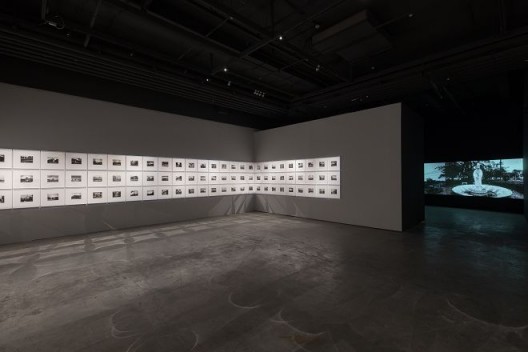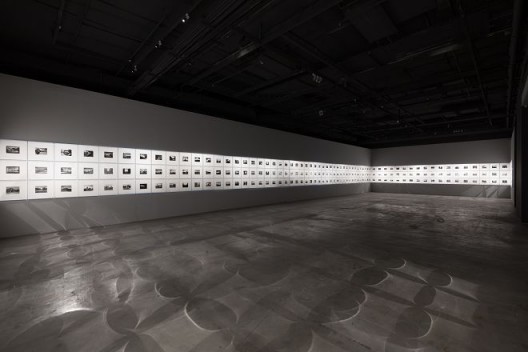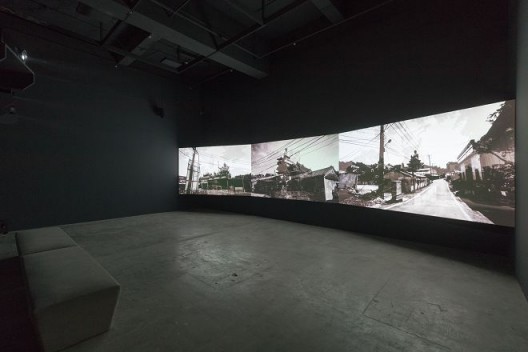Incarnations, TKG+ Taipei(B1, No.15, Ln, 548, Ruiguang Rd., Neihu Dist., Taipei 114, Taiwan), Dec 9, 2017 – Jan 28, 2018.
Taiwanese artist Yao Jui-chung’s practice is intimately tied to human history, whether economic decay or the vicissitudes of Cross-Strait relations, yet much of his recent work avoids depicting humans altogether. “Incarnation”, shown at TKG+ in Taipei, presents quasi-encyclopedic photographic documentation of temples and shrines in Taiwan. Religious practitioners, everyday visitors, and raucous festivals are excluded from Yao’s lens, which results in dispassionate images recalling (science) fiction works that ask: “What would happen if humans suddenly disappeared from the planet?” Freed from this one level of context, these black and white images allow the viewer to conversely peer deeper into the questions surrounding these sites—“Why were they built?” “What is their past, and what is their future?” “And what spirits can be said to reside in them?” Rather than timeless monuments, the shrines are revealed as the product of very human, even modern, endeavors, the physical expression of a self-created spiritual network.
When shown devoid of human life, temples and shrines may exude a feeling of ancientness. However, in Yao Jui-chung’s hands, this hoary veneer becomes more ironic than factual—while “Incarnation” does feature temples that are more than a hundred years old, the relatively short span of Han settlement in Taiwan sets a limit, and the majority of spaces depicted have a far shorter history. As Yao mentions in his catalogue notes, there was a boom in temple construction after the end of Martial Law in Taiwan in 1987, linked to the expansion of religious freedom and the opening of civil society. So, temples that are in some ways austerely represented as ancient monuments are in fact products of the messy contemporary world, created by community groups and businessmen. This contradiction slips into the series through Yao’s sly visual humor: Bodhisattvas are juxtaposed with parking lots, expressways, and amusement park dinosaurs, while elsewhere a dog statue peeks expectantly over a wall.
The primary function of these religious sites, mainly Buddhist or paying tribute to the coastal deity Matsu, is to provide for peoples’ spiritual needs, offering space for their prayers and rituals. Of course, religion’s continued power around the earth shows that it is by no means incompatible with the contemporary world. The more intriguing point here is the contrast between the temples’ modernity and their role as repositories of Chinese spiritual culture. Despite the millennia long wash of Chinese history, the instability of the past century means that certain traditions and beliefs may be best preserved in a geographical outlier like Taiwan, with a recorded history of only a few hundred years. There is a similarity here to fellow Taiwanese artist Hsu Chia Wei’s project Marshal Tie Jia, in which a deity from Jiangxi has been “relocated” to an islet near Matsu Island.

Yao Jui-chung, “Incarnation – Phra Phrom Temple, Shimen Dist., New Taipei City”, Fiber-based Gelatin Silver Print,18.5 x 23.5 cm, 2016-2017
姚瑞中,《巨神连线-新北市石门区金刚宫卧佛》,纤维纸基银盐百年相纸,18.5 x 23.5 cm,2016-2017

Yao Jui-chung, “Incarnation -Holy Light Sculpture, Factory, Yangmei Dist., Taoyuan City”, Fiber-based Gelatin Silver Print,18.5 x 23.5 cm, 2016-2017
姚瑞中,《巨神连线-桃园市杨梅区圣光雕塑厂》,纤维纸基银盐百年相纸,18.5 x 23.5 cm,2016-2017
The main issue comes down to who may claim ownership of gods, and from whom do gods derive their power. The exhibition notes pose the metaphor of shrines as “spiritual computers,” with large statues as super computers, and small ones as laptops, all connected to a central server. What Yao Jui-chung is depicting may in a way be an alternate infrastructure of Taiwan, a cybernetic spiritual network created by and physically manifesting people’s hopes for psychological comfort and a better life. Imagining this network as a cultural database seems imprecise but not inappropriate.
Yet if the power of deities stems from belief, the absence of people from the photographs complicates manners. A computer network still requires administrators and users. Without them, perhaps these mute statues lose the power instilled in them through performative ritual. Many though not all of the temples photographed are in peripheral areas—sites of agriculture or industry that have declined as Taiwan has become intermeshed in global economic networks and shifted towards a service-economy. As people migrate to large cities or away from the island altogether, gods may cease to reside in their statues. The photographs seem to preview this state of spiritual collapse.
At TKG+, prints from the series are arranged at eye level in a near-complete loop around the walls of a large empty room, creating a sense of respectful contemplation in the way that one might observe the documentation of a disaster or ruined civilization. In a side room the pictures are rearranged into a three-channel video installation, images slowly rotating through, like a methodical slideshow, with the accompanying soundtrack of a NASA recording of Saturn’s radio spectrum. Even as Yao Jui-chung’s careful compositions portray the temples as fragile human enterprises, the deep cosmic drone still implores us to experience and emphasize with their power and mystery.

Yao Jui-chung, “Incarnation – Mazu Temple, Waipu Dist., Taichung City”, Fiber-based Gelatin Silver Print,18.5 x 23.5 cm, 2016-2017
姚瑞中,《巨神连线-台中市外埔天君宮》,纤维纸基银盐百年相纸,18.5 x 23.5 cm,2016-2017

Yao Jui-chung, “Incarnation – Zhengde Cultural Monastery, Mt. Giant Buddha, Puli Township, Nantou County”, Fiber-based Gelatin Silver Print,18.5 x 23.5 cm, 2016-2017
姚瑞中,《巨神连线-南投县埔里镇正德大佛山文华院》,纤维纸基银盐百年相纸,18.5 x 23.5 cm,2016-2017




